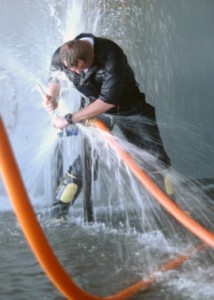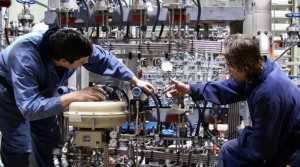Imagine that you are at the plant, all of the equipment is working, and production seems to flow without problems. That is a dream come true for a maintenance manager. Everything is working fine, right…
 The thing is that all equipment is running without stopping; but breakdowns and production stops are not the only factor that affects productivity. Think about a machine that produces something, and due to some problem it only works at 90% of its capacity. The machine is working continuously, but we are still losing 10% of production. In fact, in a 10-hour shift, losses are equivalent to the machine being stopped for one hour!
The thing is that all equipment is running without stopping; but breakdowns and production stops are not the only factor that affects productivity. Think about a machine that produces something, and due to some problem it only works at 90% of its capacity. The machine is working continuously, but we are still losing 10% of production. In fact, in a 10-hour shift, losses are equivalent to the machine being stopped for one hour!
Similarly, if the equipment produces defective pieces, we get the same effect because each discarded piece should be reworked or replaced by a new one. At the end of the day, the time spent producing defective pieces is comparable to stopping the machine altogether for that same amount of time. Continue reading
Author Archives: Claudio Insaurralde
Applying 5S series – (Part I) Introduction
Maintenance managers always want their employees to work efficiently, follow procedures, and comply with OH&E Standards. However, when the work environment is in poor conditions, workers do not feel compelled to follow the appropriate guidelines. In fact, an untidy, dirty, and unorganized working environment encourages employees to acquire bad working habits. Consequently, if we want to improve our personnel’s work ethic, we first need to evaluate whether the environment inspires people to work efficiently and correctly or if it does the exact opposite. If latter situation is presented, we need to make improvements before asking workers to change their habits. The best way to guide this improvement process is to implement 5S in the work environment.
5S is a methodology to clean, to improve, and keep the workplace in optimal conditions Continue reading
How to deal with chronic problems and emergencies (Part II)
In the fist part, I talked about problems in general and chronic problems. Now I’m going to discuss about the other type, the emergencies or acute problems.
Acute cases
 Acute cases are more critical. We are unable to fix the equipment until we identify the cause of the problem. This is an extremely tense situation, especially in fast paced environments. Usually after the most common repairing options have failed, technicians tend to start replacing every component in the system, sometimes all of them at once. This is highly ineffective and only complicates more the situation. Consequently, the most important thing in these cases is to adopt a methodical approach even if it seems to be slower. This approach is called Fault isolation Process. Continue reading
Acute cases are more critical. We are unable to fix the equipment until we identify the cause of the problem. This is an extremely tense situation, especially in fast paced environments. Usually after the most common repairing options have failed, technicians tend to start replacing every component in the system, sometimes all of them at once. This is highly ineffective and only complicates more the situation. Consequently, the most important thing in these cases is to adopt a methodical approach even if it seems to be slower. This approach is called Fault isolation Process. Continue reading
How to deal with chronic problems and emergencies(Part I)
When equipment fails we need to repair them as soon as possible, especially in a fast paced environment where availability is a critical issue.  The key to effectively solving technical problems is to quickly find the cause and take actions to fix it. However, this process is usually not as easy as it sounds.
The key to effectively solving technical problems is to quickly find the cause and take actions to fix it. However, this process is usually not as easy as it sounds.
Sometimes maintenance actions put the machine back on service even if the cause still there. In doing this, we are likely to have the same problem again in the near future. Other times the cause of the failure is not so evident, and the asset remains out of service because we are unable to find what is wrong.
Each of the cases above has its particularities and requires different maintenance approaches depending on the situation. Continue reading
Six key points to delegate effectively (Part II)

In my previous post I started talking about effective delegation. I described the first three aspects: politeness, present a reason, and describe the goal among the six point that, in my opinion, are key to successfully delegate tasks to our employees.
Let’s talk about the next three: setting deadlines, giving support and recognizing a good job. Continue reading
Six key points to delegate effectively (Part I)

The number one skill of great leaders is communication, which the leader uses in many ways. It is one of the most important talents needed by the leader to effectively delegate work to his collaborators (employees).
In my 15 years of service in the military (the first four in the Air Force Officer’s Academy), I had the opportunity to learn something about both giving orders and delegating tasks. There is quite a difference between these two even though they seem rather similar. While both have the ultimate goal of getting something done, delegating tasks leaves more room for creativity and synergy than simply giving orders.
Continue reading
Organizing your Work Orders to Maximize Maintenance Efficiency
Effective maintenance tasks for each equipment are crucial for maintenance management. Many resources are used to design the tasks in order to improve a plant’s reliability and productivity. However, the way we incorporate all tasks in work orders (WOs) and schedule them will determine the final efficiency of our preventive maintenance strategy. 
To effectively schedule the WOs, we use different criteria to group them. Each group has pros and cons, and in practice we usually apply a combination of them to get the most of our resources and increase our department efficiency.
Good News!
During this weekend the first post will be online!
Then, I will start adding new ones on a regular basis.
See you around!
Claudio

